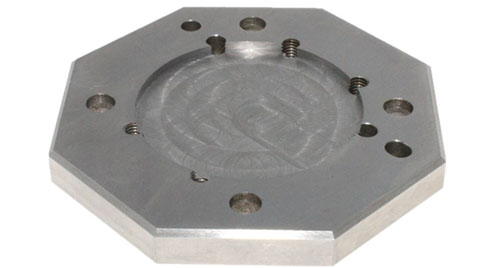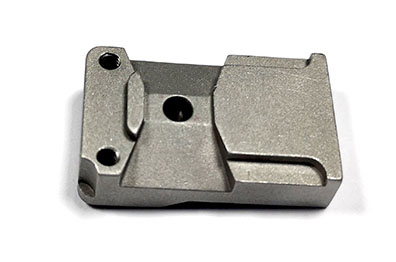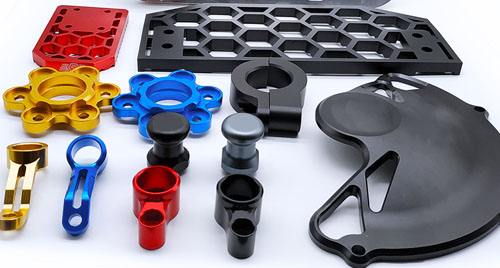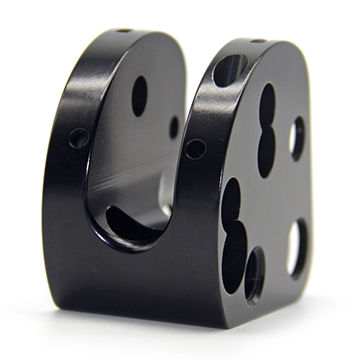Unless otherwise stated, CNC machined parts will have a “milled” surface finish. Due to the decremental nature of CNC, small tool marks will appear on the surface of the workpiece after processing. Therefore, many parts require additional processing to obtain the desired surface characteristics or performance to achieve aesthetics, corrosion resistance, wear resistance, or other purposes.
Here, we will discuss the most common metal CNC surface finishes to help you choose the most suitable surface finish for your application.
Common Machined Surface Finishes
Standard, As Machined

It is our standard surface finish. As machined parts will have minor visible tool marks, and the standard value of the processed surface roughness (Ra) is 3.2 μm. Finishing passes can be applied to reduce the surface roughness to 0.8, 0.4 μm or lower. This will increase the production cost of the parts due to the additional processing steps and stricter quality control.
Because the machined parts can also be ground or polished to reduce the surface roughness, thereby improving their surface quality and aesthetics. Grinding and polishing will remove some materials that affect the dimensional tolerance of the part.
As Machined is an affordable and fast option, usually used for non-display applications.
Bead Blasting Or Sandblasting

Bead blasting will add a uniform matte or satin surface finish to the machined parts, thereby eliminating tool marks. During the bead spraying process, compressed air is used to form a high-speed jet beam, which sprays the material onto the surface of the workpiece to be processed at high speed, which can remove some materials and smooth the surface. Can cover key surfaces or features (such as holes) to avoid dimensional changes, which will incur some additional costs.
It can clean small burrs on the surface of the workpiece, improve the finish of the workpiece, expose the workpiece to a uniform metallic color, and make the appearance of the workpiece look more beautiful.
Spray beads are mainly used for visual purposes. This is a manual process, so the result depends to a certain extent on the skill of the operator. The size of the air pressure and the size of the glass beads are the main process parameters. Glass beads have different sizes (from thick to very thin), just like sandpaper has different sizes and grades.
MT-11010 Light Bead Sandblasting-can remove light knife marks and light sandpaper scratches, and leave a smooth and even gloss.
MT-11020 heavy bead blasting-removes heavy cutter marks and scratches left by sandpaper, and has a light-colored appearance.
Anodizing (Type II & Type III)

Anodizing is an electrolytic oxidation process. During the electrolysis process, the part is immersed in a dilute sulfuric acid solution and a voltage is applied between the part and the cathode. The electrochemical reaction consumes the material on all exposed surfaces of the part and converts it to hard aluminum or titanium oxide. Masks can be used on surfaces with critical dimensions (such as threaded holes) or surfaces that must remain conductive to prevent anodization. It can improve the surface hardness and wear resistance of aluminum parts and prolong the service life.
Anodizing is the most widely used for surface treatment of aluminum and titanium machined parts. Anodized parts can be dyed in different colors-black, red or gold are the most common
By changing the current, anodizing time, concentration and temperature of the solution, coatings with different thicknesses and densities can be formed:
Type II anodizing
Type II anodization, also known as “standard” or “decorative” anodization, can produce coatings up to 25 μm thick. The typical coating thickness depends on the color. For parts dyed black, the thickness can be between 8-12 μm, and for transparent (undyed) parts, the thickness can be between 4-8 μm.
Type II anodizing is mainly used to produce smooth and beautiful parts, and provides good corrosion and limited wear resistance.
Anodized type III (hard coating)
Type III anodizing is also known as “hard coating” anodizing, which can produce coatings up to 125 μm thick. Unless otherwise specified, the thickness of a typical Type III anode coating is 50 μm.
Type III anodizing treatment produces a high-density thick ceramic coating with excellent corrosion and wear resistance, suitable for functional applications. Compared with Type II anodizing, it requires stricter process control (higher current density and constant solution temperature close to 0oC), and therefore higher cost.
Powder Coating

Powder coating is the process of spraying powder onto the surface of parts under the action of static electricity. The process of powder coating is similar to spraying painting, but “paint” is a dry powder rather than a liquid. The powder is evenly adsorbed on the surface of the aluminum processed parts, and then baked into the parts through the oven. This results in a strong, wear-resistant and corrosion-resistant coating that is more durable than standard spray coating methods. Various colors can be used to achieve the desired aesthetics of the parts. In terms of mechanical strength, adhesion, corrosion resistance and aging resistance, powder coatings are better than wet coatings. It can achieve a high utilization rate of 100% and is very environmentally friendly.
Powder coating is a strong, wear-resistant coating that is compatible with all metal materials and can be used in combination with sandblasting to produce parts with smooth, uniform surfaces and excellent corrosion resistance.
Multiple layers can be applied to produce thicker coatings, with typical thicknesses ranging from about 18 μm to a maximum of 72 μm. There are many colors to choose from.
SANS provides various surface finishing to ensure that your machined parts meet all of their surface characteristics. The most common surface finishing include sand blasting, anodizing and powder coating. We also provide chemical film (conversion coating), electroless nickel plating, gold or silver, and custom surface treatment.
Inquiry NowTips to Improve CNC Machined Parts Finishing
We cannot ignore the importance of an impeccable surface finish, so how to improve the machined parts finishing?
1. Adhere to the correct feed and speed (increase the speed and reduce the feed)
The correct way to handle finishing is to increase surface feet per minute (SFM) and reduce inches per revolution (IPR). The former helps reduce built-up edge (BUE), which helps to extend the life of the tool, while the latter can extend the life of the blade.
2. Choose the right cutting method
When machining parts with a milling machine, there are two methods: clockwise milling and counterclockwise milling. Clockwise milling has a better surface effect than counterclockwise milling.
3. Use new and efficient tools
The efficiency and performance of CNC machine tools are inseparable from the tools. For the processing of high-precision parts, not only need to focus on the perfect process, but also must choose and use new and efficient tools.
4. Use the best CNC machining program
Optimize the CNC machining program to provide the best CNC data for machining to improve quality. Unnecessary pauses and pauses also hamper the correct finishing work.
5. Minimize deflection and chatter, keep tool rigid
In order to get good results, you need to ensure that your tool does not deflect or shake.
6. Do not use the same tools for roughing and finishing
Learn to retain roughing tools for roughing and finishing tools for finishing. We may want to cut costs and use them in different processes, but this may not provide the highest quality finishing.
We mainly provide Custom Precision Machined Parts as your design, No MOQ and can quote and delivery as fast as 1 day, which is more suitable for OEM and No standard project.


